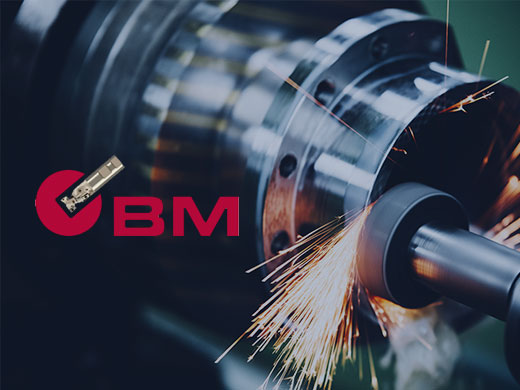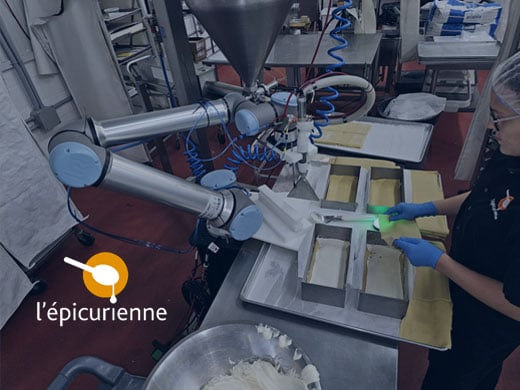Published: 01/05/2023
Customer
Hundreds of thousands of tools flow in and out of Baron Tools every week. As a fast-growing distribution company in Greater Montreal, Baron Tools offers an extensive range of tools to the machining industry.
Not long ago, this rapid movement of inventory created major headaches for the Baron team because they were managing product flow with paper documents and accounting software stretched beyond its capacity.
As a result, Baron did not have an accurate ongoing view of its stock position or profitability until the end of an accounting period. Even then, the owners knew their most accurate numbers would only come once a fiscal year when a physical count of inventory was done.
Naturally, this lack of visibility into company processes greatly impacted productivity and profitability — until the business owners decided to transform the way they did business digitally.
To gain insight into this transformation, we spoke to Hugues Dumont, Partner and Director of Operations at Baron Tools. Our interview has been edited for brevity and clarity.
What key challenges did you face when you bought the company?
A: This is a fast-moving business with a lot of moving parts. When my partners and I came in 2018, the company was handling 30 to 40 shipments per day, and 90% of the time, the goods we received in the morning were shipped in the afternoon. So we warehoused very little. We simply couldn’t stay on top of all these moving items, even though we had inherited a very good team from the previous owners - smart, good people who knew their stuff and were go-getters.
What was the root of the problem?
A: Our team was using outdated tools. They were dealing with a lot of paper, too much paper, and they were tracking transactions and inventory with Acomba (accounting software).
That software worked well in the early days of the company, let’s say between 2006 and 2010, when the sales volume was more modest. But when my partners and I came on board, we had aggressive sales goals. As a sales rep on the road, I quickly noticed problems with inventory management.
I’d get an order and I’d be anxious about accepting it because I wasn’t confident we could find all the goods we needed. Or we didn’t know how much was on backorder, so we’d order more. Sometimes, a dumb thing, like losing a delivery receipt, would lead us to think we didn’t have goods that we did have in stock.
Our software and systems simply couldn’t keep up, and I’d end up on the phone with customers. I can tell you; this was not fun.
How did you deal with these challenges?
A: Luckily, in previous businesses, I had become familiar with ERP software from implementations I had participated in. I knew what a difference they could make in a business.
I put a small team together and we sat down to analyze our business processes and document what we really needed. We learned a lot from that analysis.
What did you conclude about your ERP requirements?
A: Like I said, we wanted to grow aggressively, so our ERP system had to scale to integrate that business growth.
Second, we wanted to eliminate the big headaches we had with inventory. We wanted everyone in the company to know in real time what stock we had and didn’t have. That meant automatic monitoring of purchasing and receiving and backorders.
Third, we wanted to get rid of paper, as much as possible. We were swimming in paper, and it was driving us crazy.
Fourth, we wanted to easily keep track of price lists that were associated with the quotations we submitted. That way we could always respond quickly to customers who wanted to know prices.
By integrating price lists with the quotation, we also wanted to easily calculate our profit margins for any customer. Staying on top of our margins in real time was important. We summarized all these requirements in a document.
What other considerations about the ERP system did you note?
A: Based on my experience, I didn’t want to burn money customizing an ERP to match our needs. We’re a
distribution company, so our ERP had to suit a company like ours.
Since our growth was going to come in stages, we also wanted the ERP to accommodate that
evolution.
And, of course, budget was an important consideration. Fortunately, Investissement Québec was very
receptive to our growth plans and our need for digital transformation. Their subsidies really helped.
What was your selection process for the ERP system?
A: We got quite a few submissions, then did the rounds of the demos with my team, and shortlisted four companies, including Fidelio. We knew that competitors were already using Fidelio.
But we’re a skeptical bunch here, so we wanted to choose an ERP that we loved, and not choose one simply because others were using it.
The shortlist became shorter. We dropped Acceo Solutions, then it was just Fidelio and Acumatica.
How did you make your final choice of ERP?
A: A few key factors tipped the balance. We knew from the demos that Fidelio developers had a thorough understanding of the day-to-day processes and information needs of distribution companies. That was a big plus.
We also had a good connection with the Fidelio team. We sensed a general transparency about issues big and small. That built our trust. And we thought Fidelio was a great value. We were going to get a lot of relevant functionality for what we were paying. What’s not to like about that?
How did the ERP implementation go?
A: Smoothly, because we took pains to plan it out. We didn’t want the implementation to hurt the business in any significant way.
Our team sat with the Fidelio people, and we mapped out the implementation, step-by-step. To train our team, we held one workshop and assigned homework for the follow-up session. These workshops were recorded so anybody could review them at any time.
What business results did you see after the ERP implementation?
A: We saw big improvements in our major processes. Using Fidelio, our shipping and receiving teams reduced the time spent on their usual tasks by 25%. With less paperwork, these teams are now helping us with other tasks.
Our purchasing process was transformed. We used to issue P.O. numbers manually by compiling all the orders. Now, as soon as an order is taken, a purchase is created automatically. As a result, the purchasing team reduced the time on their tasks by 50%. So now, they can focus on tasks that we were doing less well, like supplier and customer returns.
Remember, these efficiencies are also possible because we have excellent employees who adapted well to a powerful new system.
What other benefits did you note?
A: Before Fidelio, it took us twenty or so clicks to find out how we were doing on a metric. Analysis view was a pleasant surprise. This feature hadn’t even been part of our list of requirements. With a few clicks, I can compare sales trends this year versus last year.
Every business function has its own dashboard of KPIs (Key Performance Indicators). Anybody walking into their department can see their key indicators immediately. The indicators are easy to customize. We do it ourselves, which is great.
Reports are easy, too. Let’s say a salesperson on calls needs last month’s sales by customer. Producing the report is a no-brainer.
The salespeople find the reporting tool helpful because it helps keep them on top of their numbers and achieve their goals.
What has Fidelio’s customer service been like after the implementation?
A: It’s as good as it’s ever been. We feel understood and supported. Our collaboration is a pleasure.
What are you planning next for your ERP system?
A: We want to give customers access to some of their data, such as an account statement or a backorder. We also want to give them the freedom to order on their own, based on their account history, without our needing to intercede.
We haven’t automated invoicing yet. That’s our next priority. We need to build the templates for the invoices and the emails that go with them.
We want Fidelio to do even more, so our team can do more.

Are you a manufacturer or a distributor? To find out more about the various functionalities and flexibility of the Fidelio ERP system, contact us.





